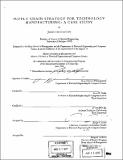| dc.contributor.advisor | Alvin W. Drake and Sandy D. Jap. | en_US |
| dc.contributor.author | Creighton, John (John Stuart), 1970- | en_US |
| dc.contributor.other | Leaders for Manufacturing Program. | en_US |
| dc.date.accessioned | 2006-11-08T16:24:16Z | |
| dc.date.available | 2006-11-08T16:24:16Z | |
| dc.date.copyright | 2000 | en_US |
| dc.date.issued | 2000 | en_US |
| dc.identifier.uri | http://hdl.handle.net/1721.1/34713 | |
| dc.description | Thesis (M.B.A.)--Massachusetts Institute of Technology, Sloan School of Management; and, (S.M.)--Massachusetts Institute of Technology, Dept. of Electrical Engineering and Computer Science; in conjunction with the Leaders for Manufacturing Program, Massachusetts Institute of Technology, 2000. | en_US |
| dc.description | Includes bibliographical references (leaves 44-45). | en_US |
| dc.description.abstract | This thesis explores a variety of logistics strategies for Qualcomm Wireless Business Solutions (QWBS), focusing on the OmniTRACS system and MVPc display. I develop and apply a model that considers the interactions of inventory processing and inventory movement in the context of total supply chain costs. My goal is to minimize purchased product inventory while reducing product lead-times. Without a formal model, supply chain organization decisions tend to replicate existing designs because it is difficult to find a better solution by trial and error due to the numerous alternatives and the number of variables involved. To develop an understanding of the issues at QWBS, I began by researching technology manufacturing supply chains. I also developed a cost model for analyzing QWBS's supply chain. The final form of this model is a series of spreadsheets which accepts cost data, lead times, and variable demand as key inputs, and produces overall supply chain cost distributions. The supply chain is modeled as a series of processing nodes and transfer links. The model derives its results by simulating variable demand and summing the cost contributions of the nodes and links for each trial. The supply chain research and the cost model provide Qualcomm with a realistic and usable tool to compare both intra- and inter-company supply chain designs in terms of overall channel costs. Furthermore, my results suggest that QWBS should focus its direct shipping supply chain efforts on customers whose demand variation is smaller than QWBS's overall customer average. | en_US |
| dc.description.statementofresponsibility | by John Creighton. | en_US |
| dc.format.extent | 45 leaves | en_US |
| dc.format.extent | 2463688 bytes | |
| dc.format.extent | 2463443 bytes | |
| dc.format.mimetype | application/pdf | |
| dc.format.mimetype | application/pdf | |
| dc.language.iso | eng | en_US |
| dc.publisher | Massachusetts Institute of Technology | en_US |
| dc.rights | M.I.T. theses are protected by copyright. They may be viewed from this source for any purpose, but reproduction or distribution in any format is prohibited without written permission. See provided URL for inquiries about permission. | en_US |
| dc.rights.uri | http://dspace.mit.edu/handle/1721.1/7582 | |
| dc.subject | Sloan School of Management. | en_US |
| dc.subject | Electrical Engineering and Computer Science. | en_US |
| dc.subject | Leaders for Manufacturing Program. | en_US |
| dc.title | Supply chain strategy for technology manufacturing : a case study | en_US |
| dc.type | Thesis | en_US |
| dc.description.degree | S.M. | en_US |
| dc.description.degree | M.B.A. | en_US |
| dc.contributor.department | Leaders for Manufacturing Program at MIT | en_US |
| dc.contributor.department | Massachusetts Institute of Technology. Department of Electrical Engineering and Computer Science | |
| dc.contributor.department | Sloan School of Management | |
| dc.identifier.oclc | 45579042 | en_US |
